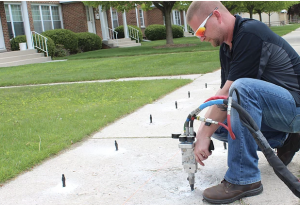Concrete Leveling Mudjacking
Soil raising, also known as “slab lifting” or “concrete leveling,” is a quick and inexpensive way to level sagging concrete foundations, sidewalks, patios, and driveways. Simply put, soil lifting is a service that lifts existing concrete that has settled and is no longer uniform with the surrounding slabs. Mudjacking is a method of lifting a sunken concrete slab by pumping a mud-like mixture under the concrete to level it again. Concrete Mudjacking is the process of pumping water, sandy loam and concrete under a concrete slab to lift it up.
The term Mudjacking (Mud Jacking) comes from the use of a mixture of soil and Portland cement to inject the subsoil to hydraulically lift the concrete slab. Concrete Mudjacking can solve many homeowners’ problems with concrete sagging, as well as stabilizing hollow (but not sinking) slabs. Large injection holes made for drilling can weaken the structural strength of the concrete, making it more prone to cracking in the future.
Retaining walls or other obstructions that are too close to the slab can also prevent mud from passing through. Dirt can lift a slab, but inaccurate sewage flow can cause walls to rise more in some places than others. You should not use a load-bearing board primer because the concrete is too thick to fill thin cracks. In most cases a mud lift will not be able to lift both the slab and the heavy baffle above it. Concrete raising (mudjacking process) is a repair technique with polyurethane concrete to level sunken concrete, by making small holes on the cement an injecting a slurry mixture or concrete mixtuture, that is the leveling process for slab jacking.
Slab lifting or slab fixing is the traditional fixing procedure. As the mixture is pumped under the settling plate, it fills any gaps and creates pressure on the settling plate which lifts the surface up. The mortar or foam is then injected in large, concentrated amounts, sufficient to fill the hollow spaces below and gradually lift the concrete foundation (and all the weight above it) into a suitable position. This material is injected through a series of holes drilled into the existing concrete and expanded to push the fallen slab back into place.
This failure of the material can cause the concrete to sag again if there is not enough drainage and/or cracks around the area, and the joints are not sealed to prevent water from getting under the concrete. The injected material is very heavy (30-50 times heavier than its polyurethane equivalent) and causes a new cycle of soil compression (and foundation settlement) under the concrete slab.
Although Poly is impervious to water and will last forever for that reason, it does not fill every little gap under the concrete slab, so any water moving under this repair can erode the ground. Self-levelling concrete can be a lot cheaper than primer, but you can only use it if the slab hasn’t sagged more than an inch. In addition, this type of concrete requires erosion and other major foundation problems to be fixed before it can be used.

When concrete is poured outside, be it a driveway, patio, walkway, it must include a gradual slope away from the house. If you don’t have a slab foundation and the concrete in question is inside your house, the slab won’t really be “flat” (in the textbook sense). Garage floor dirt can be completely different from foundation slab clay, mainly because some surfaces require additional support that may require other materials and leveling methods to achieve.
The most important benefit of a foundation jack is correcting uneven concrete and adding structural support. In fact, you can repair it with concrete or clay leveling, filling in the void below the surface to support the structure using a variety of methods. In each case, holes are drilled into the floor that go through the concrete foundation and into lower recesses (mud holes are larger and harder to repair).
The earth drilling process begins with the strategic drilling of holes 1″ to 2″ wide and injecting material to fill any voids under the slab, lifting sagging concrete in minutes. Sand drilling is less traumatic than standard drilling because the operator can pump mud from under the sides without drilling holes in the slab. Slabjacking is much cheaper than polyjacking, a similar method that uses expensive polyurethane foam instead of concrete mortar to lift stabilized concrete slabs.
Slab lifting is another type of concrete lifting, but it does not use cement or limestone mortar as the filler. The injection of drilling fluid and polyurethane lifts the concrete foundation onto a densely filled, swollen wave of slurry (a mixture of solid backfill material that includes silt, sand, concrete, crushed limestone, etc. The liquid slurry is pumped into 2-inch holes through a primed under submerged in water on the concrete surface and slowly lifts the surface from below the surface, then hardens as it dries to form a strong support.
Traditional Mudjacking uses a soil-based clay slurry or sand/cement mixture that does not flow well and can break down and lose support much faster, requiring a higher return rate to lift the concrete. Mudgeking is used to elevate concrete surfaces such as porches, driveways, or patios by pumping a mixture of water, concrete, and soil under the slab through a hole to level it and avoid sinking or collapsing due to gaps under the slab. Once the concrete begins to lean or sag, it can lead to tripping hazards, unwanted water runoff, or serious foundation problems.